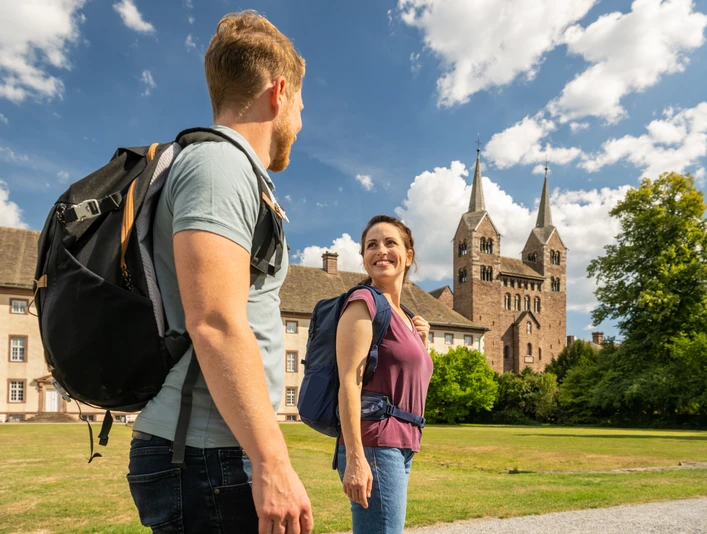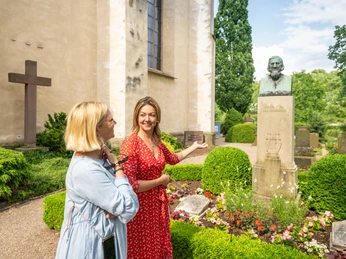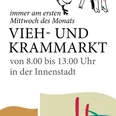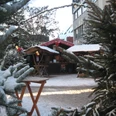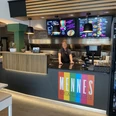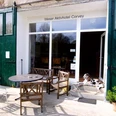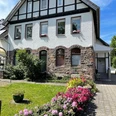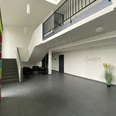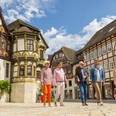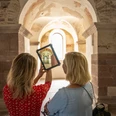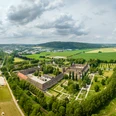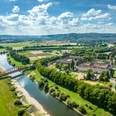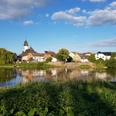The former Benedictine abbey of Corvey was founded in 822 by order of Charlemagne and is considered one of the most important monasteries in medieval Germany. After almost 1000 years of monastic life, visitors are now greeted by a baroque palace complex in ducal ownership. The early medieval westwork of the abbey church is visible from afar. It forms the visible core of the World Heritage Site and, together with the baroque monastery building and the extensive princely library, fascinates guests from all over the world.
The Westwork of the baroque abbey church of Corvey is 1,200 years old and one of the few buildings from the time of Charlemagne that has been preserved in its essential parts. In fact, it is the only surviving example of the westwork building type from this period. The original vaulted hall with columns and pillars on the first floor and the main room on the upper floor make Corvey one of the most striking examples of the so-called "Carolingian Renaissance".
In addition to the magnificent Imperial Hall, historical state rooms and living rooms from the 18th and 19th centuries can be seen inside the castle. The Princely Library houses around 75,000 volumes in 15 rooms, furnished with magnificent bookcases from the late classicism and Biedermeier periods. It is one of the most important private libraries still in existence in Germany. The grave of the Corvey librarian and poet of the German national anthem, Hoffmann von Fallersleben, is located in the adjacent cemetery.
The newly designed permanent exhibition "The Millennium of the Monks" was opened for the 2024 season. A variety of media stations and precious exhibits from the parish of St. Stephen and Vitus bring the golden age of the monks to life.
Corvey is not only a famous monument and museum, but also a lively venue for events. Best known are the Corvey Music Weeks, which are characterized by classical music. Every year since 1954, renowned ensembles and soloists from Germany and abroad have been performing in the Kaisersaal and the Corvey Abbey Church with its outstanding acoustics in May and June.
Under the twin towers of the westwork and under the protection of the high abbey walls, the Remtergarten not only grows beautiful roses, rare perennials and fragrant ornamental plants, but also berries, fruit, almost forgotten vegetables, medicinal herbs and medicinal plants. The modern interpretation of the monastery garden is part of the Huxarium garden park in Höxter;
The Westwork of the baroque abbey church of Corvey is 1,200 years old and one of the few buildings from the time of Charlemagne that has been preserved in its essential parts. In fact, it is the only surviving example of the westwork building type from this period. The original vaulted hall with columns and pillars on the first floor and the main room on the upper floor make Corvey one of the most striking examples of the so-called "Carolingian Renaissance".
In addition to the magnificent Imperial Hall, historical state rooms and living rooms from the 18th and 19th centuries can be seen inside the castle. The Princely Library houses around 75,000 volumes in 15 rooms, furnished with magnificent bookcases from the late classicism and Biedermeier periods. It is one of the most important private libraries still in existence in Germany. The grave of the Corvey librarian and poet of the German national anthem, Hoffmann von Fallersleben, is located in the adjacent cemetery.
The newly designed permanent exhibition "The Millennium of the Monks" was opened for the 2024 season. A variety of media stations and precious exhibits from the parish of St. Stephen and Vitus bring the golden age of the monks to life.
Corvey is not only a famous monument and museum, but also a lively venue for events. Best known are the Corvey Music Weeks, which are characterized by classical music. Every year since 1954, renowned ensembles and soloists from Germany and abroad have been performing in the Kaisersaal and the Corvey Abbey Church with its outstanding acoustics in May and June.
Under the twin towers of the westwork and under the protection of the high abbey walls, the Remtergarten not only grows beautiful roses, rare perennials and fragrant ornamental plants, but also berries, fruit, almost forgotten vegetables, medicinal herbs and medicinal plants. The modern interpretation of the monastery garden is part of the Huxarium garden park in Höxter;
Good to know
Openings
Individual group tours can be booked all year round with advance notice.
Due to necessary construction and restoration work, there may be restrictions on visiting the Westwerk.
Due to necessary construction and restoration work, there may be restrictions on visiting the Westwerk.
Price info
Price adult: €14.00
Price child: €2.00
Price reduced: €13.00
Individuals: € 14,00 €
Groups of 15 persons or more: € 13.00
reduced: € 11,00
Children (from 3 - 17 years): € 2,00
Public guided tour (additional per person): € 5.00
Church ticket only
Individuals: € 5.00
reduced: € 4,00
Guided tours:
Group tour (up to 25 people): € 70.00
Group tour (up to 25 people) foreign language: € 80.00
Groups of 15 persons or more: € 13.00
reduced: € 11,00
Children (from 3 - 17 years): € 2,00
Public guided tour (additional per person): € 5.00
Church ticket only
Individuals: € 5.00
reduced: € 4,00
Guided tours:
Group tour (up to 25 people): € 70.00
Group tour (up to 25 people) foreign language: € 80.00
Information on reduced prices: Pupils, students, people with physical disabilities
Eligibility
Bad Weather Offer
Suitable for any weather
for Groups
for Class
for individual guests
Suitable for the Elderly
Suitable for Pushchair
for Children of the age of 10 upwards
Foreign Language
German, English, French
Other Furnishing/Equipment
Toilet
Accessibility
General Information on Accessibility
Corvey ist trotz seiner 1.200 jährigen Geschichte ein Ort, der möglichst allen zugänglich sein soll. Mit Ausnahme des Johanneschors im Westwerk sind alle Bereiche der Welterbstätte mit dem Rollstuhl zu erleben.
- Die Wegeverbindungen sind mit feinem Split geschottert. Eine Unterstützung beim Schieben ist ratsam.
- Die Kirche ist durch den Haupteingang im Westwerk zu erreichen.
- Der barrierefreie Eingang in das Konventsgebäude befindet sich an der rechten Ecke der Westfront.
- Die Ausstellungs- und Besucherräume im Konventsgebäude sind über Rampen zugänglich, zwischen den Etagen verkehrt ein Aufzug.
- Behindertengerechte Toiletten stehen im Konventsgebäude und im Restaurant zur Verfügung.
- Für gehbehinderte Besucher kann ein kostenloser Rollstuhl ausgeliehen werden.
- Blinden- und Behindertenbegleithunde können in die Ausstellungsräume mitgenommen werden.
Directions & Parking facilities
By car and bus
If you are traveling by car or bus, use the navigation address "Corvey". The World Heritage Site is also well signposted.
By train
Train stop "Höxter-Rathaus", bus service to bus stop "Corvey". Alternatively, take a cab or walk along the Weser: approx. 30 minutes (2 km).
By bike
Corvey is located directly on the Weser Cycle Route and the European Cycle Route R1 between Höxter and Holzminden.
If you are traveling by car or bus, use the navigation address "Corvey". The World Heritage Site is also well signposted.
By train
Train stop "Höxter-Rathaus", bus service to bus stop "Corvey". Alternatively, take a cab or walk along the Weser: approx. 30 minutes (2 km).
By bike
Corvey is located directly on the Weser Cycle Route and the European Cycle Route R1 between Höxter and Holzminden.
More information
Group tours available all year round on request
License (master data)
Tourist-Information Höxter
Nearby
